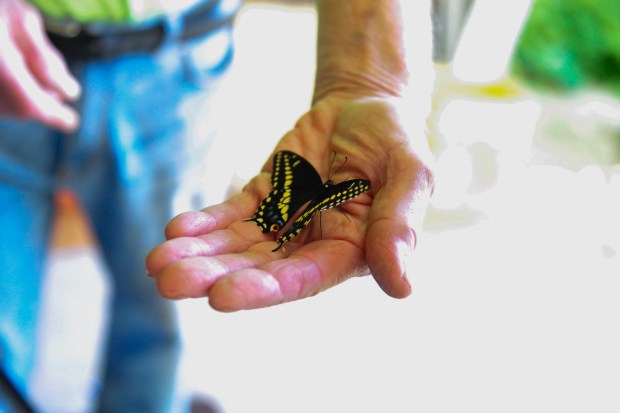Since he emerged as a butterfly rescuer in 2007, Bob Erlich has released more than 36,000 monarchs and swallowtails into Chicago’s suburban landscape.
“It never gets old,” the 78-year-old Evergreen Park resident said. “From that first release to today, it’s still wonderful to watch them take flight.”
After reading a newspaper story 18 years ago about the endangered monarch, the former jewelry salesman decided to pivot a job layoff into a retirement cause.
He ripped out evergreen bushes on his suburban property and dedicated the space to native plants. One thing led to another and before long, his front yard, backyard, driveway and garage were all converted to butterfly way stations.
Today, the Erlich still spends eight or more hours outdoors, tending to his pollinator plants, amending the soil and watching eggs transform into butterflies inside protected aquariums.
Pollinator season is just getting underway, he said. This is a great time to get involved, whether you’re a tireless gardener or someone who’d be happy to watch the metamorphosis unfold in a pot on the front porch.
There are lots of pretty plants out there, Erlich said, but if you want to help the pollinators, you have to go native.
Milkweed draws the butterflies and invites them to lay their eggs. It also provides the enormous feast the caterpillars need to fuel their own metamorphosis from egg to larva to butterfly.
In this photo from 2019, Bob Erlich gets ready to release a black swallowtail butterfly that emerged just days before in his garage. (Gary Middendorf/Daily Southtown)
Once emerged, the zinnias, coneflowers and marigolds provide nectar for the fluttering insects.
“My main goal is to get people to help but, more important, to get them to want to help,” Erlich said. He gives talks at garden clubs and the Evergreen Park Library, where he also holds an annual plant sale and maintains the butterfly garden on site.
To promote the cycle, you need the plants that the butterflies either lay their eggs on or the ones they take nectar from, he said. Many of those particular flowers and shrubs can be spied growing along highways on the drive to southern Illinois.
Milkweed is the most essential of butterfly friendly plants. But it’s not likely to be sold at garden centers because it lacks pizzazz, he said.
Erlich grows the common, swamp and tropical varieties, and sells as much as he can.
Buyers vary in terms of commitment. Some have beautiful gardens. Some have small spaces dedicated to pollinators.
“I’ve had people tell me they’ve seen the whole cycle happen in a pot right on their porch,” he said.
Monarchs prefer tender young plants, he said.
“They’d rather lay an egg on 4-inch plant than 4-foot plant. I don’t know why. That’s just the way they are,” he said, chuckling. “They’re cute little things.”
Of course, Erlich said, “The more you have, the better, the more you’ll likely see butterflies in your backyard.”
Much like the hummingbird’s long migration, the monarch travels a great distance to and from Mexico each year. It’s prudent, he said, to greet their return with an appropriate feast.
The journey, Erlich said, is precarious and one that nature lovers enjoy talking about.
“If they meet terrible storms crossing the Rio Grande, their first eggs could get wiped out,” he said. “One year, they met terrible wildfires in Texas. It stunted the population.”
To help give them a fighting chance against a variety of predators that include spiders, praying mantises and, mostly, yellow jackets, Erlich brings the eggs into one of several aquariums inside his garage. There, they safely evolve into caterpillars and then butterflies.

Bob Erlich, seen here in 2019, checks on an aquarium of monarch cocoons in his garage in Evergreen Park. (Gary Middendorf/Daily Southtown)
In the wild, he said, “If a monarch lays 300 eggs in a lifetime, we might get 10 butterflies. Because of predators.”
Many of his followers and fans call him when they spy eggs on their milkweed plants. Erlich stops by and transports the tiny ova to the safety of his garage.
But even protecting them through the metamorphosis can’t guarantee they’ll survive adulthood, he said.
“I can’t tell you how many times I’ve raised a monarch in my garage, carry it outside, gently place it on a coneflower to get dry and ready to go, and then a yellow jacket attacks them, cripples them and eats them. They’re outside the aquarium for five minutes,” he said. “Isn’t that crazy?”
But when one successfully takes flight, it is the most rewarding feeling, he said. Even for the 2,000th time that year.
The only thing that comes close to tugging his heartstrings is when he sees other humans joining the ranks.
Each year, neighbors and people he meets through the library express an interest and then embrace the cause.
His daughter, Melissa Erlich, is following in his footsteps, dedicating her property in north suburban Linderhurst to butterfly advancement. Through her Facebook page, Missy’s Monarchs of Lindenhurst, she shares the experience.
Erlich said, “I never imagined I’d be doing this for this many years. I just kind of fell into it. But it still amazes me.”
And it beats spending retirement in front of the TV, he said.
“I’ve taken a little bit of my time and now these guys are here in the world. If I didn’t do this, they wouldn’t be here,” he said.
“It feels good.”
Donna Vickroy is an award-winning reporter, editor and columnist who worked for the Daily Southtown for 38 years. She can be reached at donnavickroy4@gmail.com.





